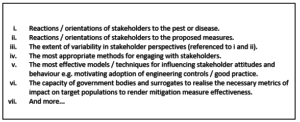Professor Julie Barnett, University of Bath Department of Psychology.
The definition of ‘risk’ is deceptively complex. It is a contested term, but simultaneously one which has become a dominant, certainly ubiquitous, currency in 21st Century life: risk, as it is commonly understood, is about the likelihood and consequence of an adverse outcome.
Despite the apparent simplicity of this notion, managing and communicating risk is one of the main preoccupations of policy-related organisations and institutions. In fact, recent years have seen their preoccupation broaden from risks that might affect people and their environment to include risks that might affect organisational reputation and legitimacy.
In a world of organisations increasingly concerned with reputational issues, it is inevitable that managing risk is a social process – but what about risk assessment? Here too societal considerations exert an influence. Choices are made that reflect values and preferences about which hazards should be a focus of attention and which should not, about which unwanted consequences should be considered and which should not.
Despite having access to cutting-edge science, influencers of public policy – even within a framework of evidence-informed decision making – are often faced with a significant degree of uncertainty alongside a requirement to develop policy options and to determine priorities. But there is more that can be done, and there are more advanced ways in which we might think about integrating the consideration of risk into public policy.
Evidence-based public policy involves more than identifying sources of harm, determining measures for its control and tempering conclusions with the acknowledgement of uncertainties in the underpinning (biological) science. It also involves understanding the ‘secondary’ risks that may be generated by public perceptions of both hazards and policies put forward as solutions, and giving a thorough account of the uncertainties involved in the policy making process.
A good example of this is the body of policy that surrounds tree health, and particularly the threat posed by invasive insects and pathogens. The UNPICK project, an interdisciplinary endeavour that I am involved in along with colleagues at Imperial College London, is concerned with investigating public perceptions of these risks. It is our hope that the findings will contribute to the evidence base for future policy decisions by expanding the understanding of public concern about this important issue, and discerning principles for effective risk communication and engagement.
When it comes to encouraging the adoption of mitigation measures to address threats posed by pests and diseases, government and its agencies are faced with significant uncertainties. Issues of changing behaviour are central to this process, particularly where there is a desire to motivate others (landowners, growers, importers, suppliers and the general public, for example) to behave differently in line with science and policy assessments of how the spread of tree pests and diseases occurs.
A number of sources of uncertainty surrounding policy delivery are summarised in the table below[1]. An appreciation of such uncertainties is potentially of great relevance to policy makers, and can complement their appreciation of uncertainty over natural science components.
The purpose of highlighting the uncertainties surrounding policy delivery is that such considerations can affect assumptions made in the assessment of mitigation measures and their impact. This distinction also serves to highlight the fact that the boundaries of uncertainty over risk control extend beyond the actual process of risk assessment itself.

Our upcoming conference Understanding Risk: From Theory to Application in Policy and Practice will consider risk and uncertainty in this comprehensive way – but will also deal with the full scope of challenges to which this approach can be applied. In addition to discussions on energy, security, climate, health and technology, we will also examine more general themes such as the role of evidence in informing risk-relevant policy, and the interaction between risk policy and regulation. The fact that this conference, an annual event for the Society for Risk Analysis - Europe and one which will draw leading academics from across the world to discuss risk, is being organised jointly with the IPR reflects the close link between understanding uncertainty and making sustainable, robust decisions at all levels of government.
You can find out more about the joint SRA-Europe and IPR conference Understanding Risk: From Theory to Application in Policy and Practice here.
[1] Taken from Barnett, J. & Weyman, A. (in press) Communication Challenges associated with the expression of uncertainty in the Plant Health Risk Register
Respond



